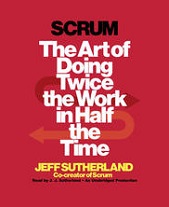[greybox]
 A review of
A review of
Scrum: The Art of Doing Twice the Work in Half the Time
Random House Business Books
About this book
by Jeff Sutherland
A good reference for Methods/How-To and Case Studies
Primary audience: Researchers, Designers and Technical Roles who are new to the topic
Writing style: Matter of fact
Text density: Mostly text
256 pages, 9 chapters
Learn more about our review guidelines
[/greybox]
For many years, “scrum” and “agile” were the biggest buzzwords of the startup scene, growing to prominence as some of the biggest teams in the world adapted the processes for daily work. What was initially a solution for IT teams was quickly incorporated by designers, who sought an effective way to coordinate their work with developers. Nevertheless, joining and synching with a scrum-oriented team may, at first, pose a challenge for those new to the subject. This is where books such as Scrum by Jeff Sutherland come into play.
Scrum is widely considered one of the best introductory books to agile on the market. Already considered a classic, it offers ground-breaking solutions and inspiration applicable to a much wider audience – even those who are in no way related to the IT scene.
Sutherland’s passion for empowering teams through efficient project life cycles is apparent, and truly convincing, from the very first pages of the book. The story of his surprising and unconventional career path, described in the first two chapters, not only makes for a pleasant read, but also shows how a single person’s inquisitiveness revolutionized modern-day businesses.
In the first part of the book, Sutherland proves that traditional (waterfall) project management brings about multiple risks and stops businesses from keeping up with the biggest players on the market, most of which had already adapted the agile methodology many years ago. In order to present his case, Sutherland draws the reader’s attention to stories of scrum origins, including his time in the Army. Here, we meet a young man who discovered his fascination for perfecting work on complex tasks in a rather unexpected way – through his daily duties as a pilot flying over a war zone. Focusing on one task at a time, perceiving mistakes as a means of enhancement, and performing after-action review – these are all elements that helped formalize scrum decades later.
Chapters three to eight are of a more precise nature, but not without practical examples derived from Sutherland’s many years of work. Here, among others, we learn what it takes to create a successful team, manage time, determine priorities, and plan deliveries (realistically). We also learn how to create and maintain team satisfaction through project transparency. These fields are all applicable not only to development, but also design teams.
Along with Jake Knapp’s more recent Sprint, Scrum will be useful for UX professionals who might have already worked with agile teams, but never fully understood how sprint scopes are formulated, product priorities evaluated, or how team velocity is being measured for better project predictability.
What makes it an even more valuable read is the author’s emphasis on how widely applicable and versatile scrum really is, even when it comes to non-tech related fields. Sutherland is not solely a “scrum-for-all” theoretician; he brings to our attention multiple case studies from his time in finance, healthcare, and higher education sectors, where scrum prevented unnecessary cost, restored order, or even salvaged whole institutions from bankruptcy.
On a more general level, Scrum may also be treated as a book of empowerment and a guideline for those who seek to become better at planning with each project, but struggle to recognize mistakes as a potential future ally. Given his expertise, Sutherland seems to refer to the old-Greek concept of “panta rei,” where we, as members of modern day teams, must constantly adapt, iterate, and acknowledge change. No project is the same, there are no shared solutions, but there are universal frameworks that can make our work more efficient.
[bluebox]
Extract
“Two decades ago I was desperate. I needed a new way of thinking about work. And through tons of research and experimentation and looking over past data I realized we all need a new way of organizing human endeavor. (…) I’ve tried to do just that, and now this methodology has become ubiquitous in the first field I applied it to, software development. At giants such as Google, Amazon, and Salesforce.com, and at small start-ups you haven’t heard of yet, this framework has radically shifted how people get things done. (…) Scrum embraces uncertainty and creativity. It places a structure around the learning process, enabling teams to assess both what they’ve created and, just as important, how they created it. The Scrum framework harnesses how teams actually work and gives them the tools to self-organize and rapidly improve both speed and quality of work”.
[/bluebox]
